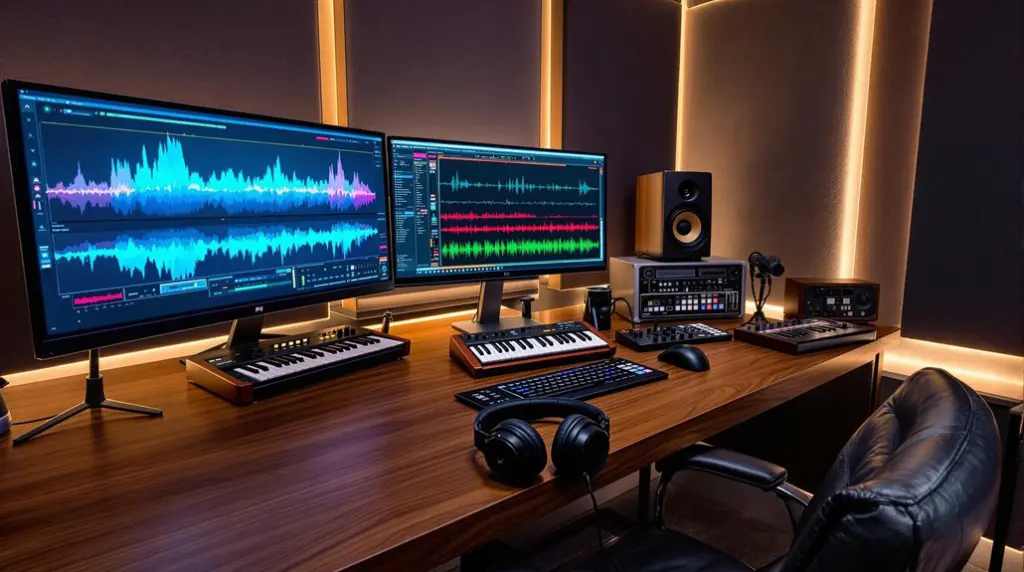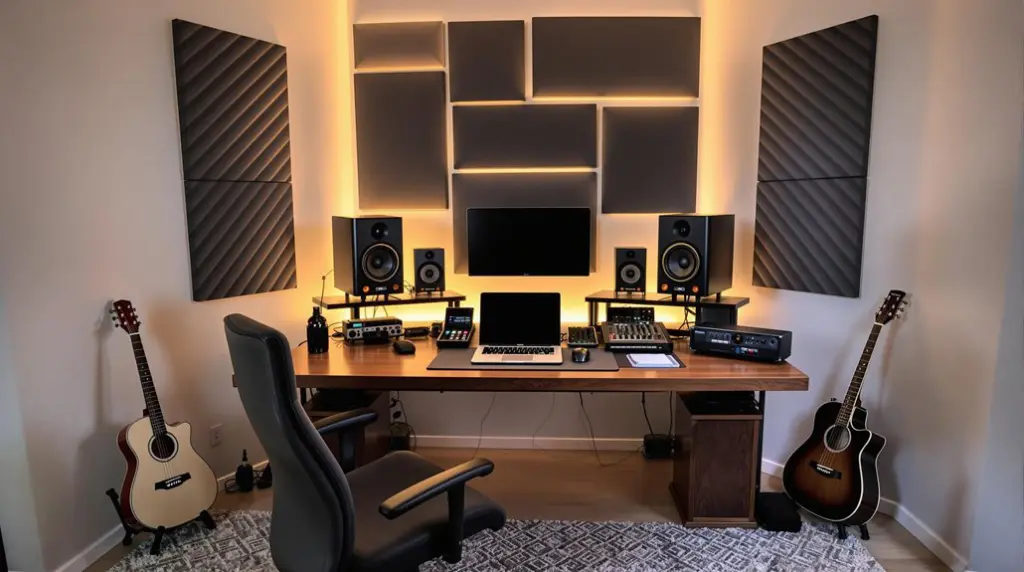To perfectly EQ your hi-hats, start by applying a high-pass filter around 150Hz to eliminate low-end mud. Next, boost the 6-9kHz range slightly to enhance brightness and presence. Apply a gentle cut near 4kHz to reduce any harshness. Use transient shaping tools and light compression to maintain clarity and impact. Pan the hi-hats slightly off-center, ensuring balance with other elements in the mix. Finally, conduct A/B comparisons with reference tracks to assess clarity and presence. These steps set the foundation for a polished sound while paving the way for a more refined mixing process.
Key Takeaways
- Apply a high-pass filter around 150Hz to eliminate low-end mud and enhance clarity.
- Boost frequencies between 6-9kHz slightly for brightness and presence in the mix.
- Cut around 4kHz to reduce harshness and create a smoother hi-hat sound.
- Use transient shaping tools and light compression to maintain clarity and enhance impact.
- Test your EQ adjustments in both stereo and mono to ensure consistent clarity across playback systems.
Understanding Hi-Hat Frequencies
When you explore hi-hat frequencies, you’ll find that they primarily occupy the upper range of the audio spectrum. The hi-hat sound typically thrives between 4kHz and 10kHz, where high frequencies impart brightness and crispness.
To help your hi-hats cut through the mix, consider a small boost around 6-9kHz, enhancing their sizzle and presence. However, keep an eye on frequency ranges near 4kHz, as cutting these can alleviate harsh high frequency sounds, letting the hi-hats sit more comfortably.
The body of the hi-hat often resides between 300Hz and 500Hz, where a small boost can add warmth if the sound appears top-heavy.
Also, applying a high-pass filter below 150Hz is essential for eliminating unwanted low-end noise, ensuring clarity in your balanced mix. Additionally, understanding frequency ranges is crucial for achieving a cohesive mix that allows your hi-hats to complement other elements effectively.
EQ Techniques for Clarity
To achieve clarity in your hi-hat sound, employing targeted EQ techniques is crucial. Start by using a high-pass filter around 150Hz to eliminate unwanted mud from the low-end frequency spectrum, creating headroom in the mix.
Next, boost frequencies in the 6-9kHz range slightly to enhance clarity and bring forward the natural sizzle of the hi-hats without introducing harshness. Additionally, apply a gentle cut around 4kHz to reduce abrasive tones that may compromise the overall mix’s clarity.
Utilize dynamic EQ to manage harsh frequencies specifically during snare hits, preventing frequency masking. Regularly reference your mix in full context to guarantee your EQ adjustments for hi-hats are effectively enhancing clarity while integrating seamlessly with other elements in the mix. Incorporating surgical EQ cuts can further refine your hi-hat sound by isolating and eliminating any resonant problem frequencies.
Managing Dynamics and Transients
Achieving ideal dynamics and transient control in hi-hats is essential for a polished mix, especially as they often serve as a rhythmic backbone in many genres.
Start by utilizing transient shaping tools to enhance the initial impact of your hi-hat sound while preserving its natural character. Apply light compression, typically around -0.1 to -2dB, to maintain clarity and presence without sacrificing transients. A high-pass filter can effectively remove unnecessary low frequencies, allowing those transients to stand out.
Employ dynamic EQ to manage any harsh frequencies that emerge during snare hits, preventing frequency masking. Additionally, consider integrating multiband compression to further refine the dynamics across various frequency ranges within your hi-hat sound. Finally, adjust the attack and sustain settings on your transient shaper for greater control over the hi-hat’s transient response, achieving the desired energy level in your mix.
Panning for Spatial Balance
Effective dynamic control sets the stage for exploring spatial placement. Panning your hi-hats properly enhances the stereo image and depth of your mix.
Here are some key considerations for panning:
- Pan hi-hats slightly off-center (30-50%) to create balance.
- Place high-pitched elements, like hi-hats, towards the sides while keeping low-pitched instruments centered.
- Combine open and closed hi-hats to mimic a real drum kit’s natural placement.
- Regularly check mono compatibility to guarantee hi-hats stay prominent across playback systems.
- Utilizing panning strategies can further enhance the spatial perception and clarity of your mix.
Testing in Full Mix Context
When you test hi-hats in the context of the full mix, you’re verifying they interact harmoniously with other instruments rather than getting lost among competing frequencies.
Use A/B comparisons with reference tracks to evaluate your EQ adjustments, maintaining a balanced frequency response. As you tweak settings, listen closely for changes in clarity and presence; verify your boosts or cuts enhance the overall hi-hat sound without causing frequency masking.
Pay attention to the dynamic range; hi-hats should maintain their impact without overpowering other elements. Additionally, consider the importance of gain staging to ensure that your hi-hats sit well in the mix without introducing distortion.
Regularly test in mono to confirm that hi-hats retain their presence across various playback systems, helping you identify any masking issues and assuring their consistent clarity in the mix.
Frequently Asked Questions
How Should You Eq a Hi Hat?
To EQ a hi-hat, focus on hi hat frequencies between 6-9kHz for clarity and presence. Use EQ techniques to balance dynamics, apply compressor settings for control, and consider stereo imaging for enhanced production workflow and audio clarity.
How to Make a Hi Hat Sound Good?
To make a hi-hat sound good, focus on hi-hat layering and sample selection. Adjust frequency range, apply pitch adjustment, and utilize velocity control for rhythm variation. Implement dynamic processing for groove enhancement and rich sonic texture.
How to Make Hi-Hats Crispier?
To make hi-hats crispier, focus on sound design through hi-hat layering, frequency range adjustments, and transient shaping. Incorporate compression techniques and stereo imaging within your mixing workflow to enhance clarity and rhythmic presence in the musical context.
How Should Hi-Hats Be Panned?
When considering hi-hat placement, utilize panning techniques to enhance stereo imaging. Aim for frequency separation and track balance by positioning them off-center, creating audio depth and spatial awareness that complements your production style and adds creative effects.
Conclusion
By mastering these five steps, you can achieve perfectly EQ’d hi-hats that improve your mix. Understanding their frequency range allows you to apply precise EQ techniques for clarity. Managing dynamics secures consistent presence, while strategic panning creates spatial balance. Finally, testing your adjustments within the full mix context assures that your hi-hats sit well alongside other elements. With practice, you’ll refine your skills and raise your productions to a professional level.




